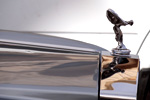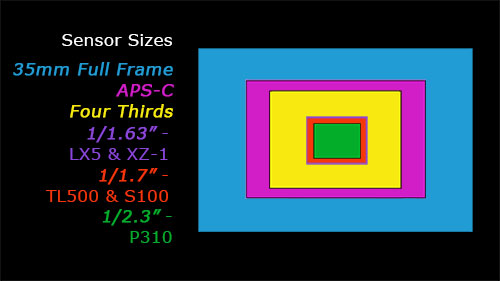Best Pocket Camera:
Shootout of FiveTop Models
The Pocket Camera Shootout
As a category, Pocket Cameras are not especially well defined. About the only concrete thing that you can say is that they should fit comfortably in your shirt pocket.
But there is a whole gaggle of Point and Shoot cameras that are also pocketable. What distinguishes a Pocket Camera? In the 2 Camera Guys taxonomy, Pocket Cameras are a step up from Point and Shooters, providing more features, better picture quality, and of course, a higher price tag.
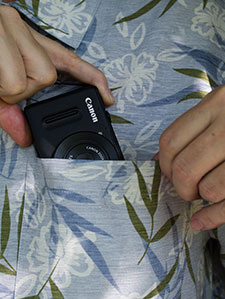
For example, most respectable Point and Shoots are under $250, while the least expensive camera in this Pocket shootout is about $325. For the extra cash, a Pocket Camera usually furnishes a superior lens system, which delivers upgraded image quality.
Speaking of lenses, we have split our Pocket Cameras into two shootouts, a Superzoom Pocket composed of competitors with long range zoom lenses, and this battle royal between Pockets with less extended zoom ranges, usually between about 24mm - 120mm.
For this April 2012 Shootout of Pocket Cameras, five of the top models that are currently available in the marketplace have been chosen: the Canon PowerShot S100, the Nikon COOLPIX P310, the Olympus XZ-1, the Panasonic LX5, and the Samsung TL500. (You can see a side-by-side comparison of the specs and features of these cameras here.)
All of these pocket cameras are capable of producing good quality photos. If you are not too demanding, one of them might be ideal for all of your photographic needs. For other folks, the portability of these mighty mites make them a great second camera that you can grab as you race out the door.
Each of the models includes one feature or another that makes it stand out from the rivals, which made picking a clear cut winner difficult. But in the end, one pocket camera rises above the rest.
The winner of our 2 Camera Guys Award for Best Pocket Camera goes to the Canon S100.
BEST POCKET CAMERA
Canon PowerShot S100
$405 with 5x Optical Zoom Lens, 12.1 MP - (More Specs)
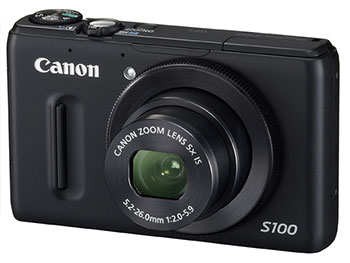
To begin, the Canon S100 is the smallest camera in this shootout, (the Nikon P310 is the lightest by decimal points). When you power down the S100, a two-piece plastic protector covers the 24mm - 120mm lens as it retracts into the slim body.
With its svelte dimensions and rugged build, this Canon is undeniably portable, even fitting comfortably in the back pocket of your Levi's - depending on the size of your derriere. Just remember not to sit down.
The image quality of the S100 is on par with the other cameras in this group, which means that it is good - not great - but just dandy for everyday snapshot and Facebook-like applications. (Read the Compromises section below.)
The S100's zoom range of 5x is the longest in this shootout, giving you a little more reach on the telephoto end, which is helpful when shooting sporting events.
Though not the clear champ in every phase of the shootout, the Canon S100 ticked most of the boxes and earns the Best Pocket Camera award.
More about the Canon PowerShot S100.
Olympus XZ-1
$495 with 4x Optical Zoom Lens, 10 MP - (More Specs)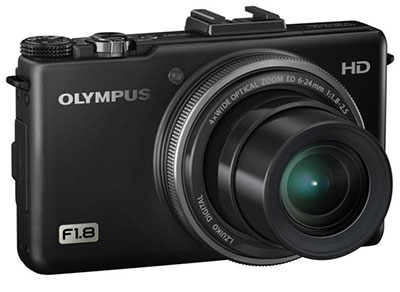
The Olympus XZ-1 is the most expensive model in this shootout, which usually drops it down the list.
But in a Fifth Avenue Easter Parade real world test, it yielded the consistently best, sharpest and most pleasingly colorful images, which pushes it right back up the list and in serious contention for the top spot.
Even though the XZ-1 lens does retract, the camera weighs almost 40% more than the Canon S100 and it will strain a shirt pocket.
In addition, the XZ-1 only shoots 720p video, which is fine for YouTube, but not as high of resolution as Canon's 1080p, which looks better on a big screen HDTV.
Then again, if your main deciding factor is still image picture quality, give the XZ-1 a long look. And while you are considering spending around $500, you might want to compare it to the similarly priced Sony Alpha NEX-C3 mirrorless camera.
Nikon COOLPIX P310
$330 with 4.2x Optical Zoom Lens, 16 MP - (More Specs)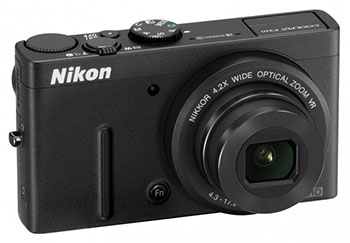
Just looking at the specs for the newly released Nikon P310, you may wonder why it's not the king of the hill.
It's the lightest and only a whisker larger than the Canon S100, making it truly pocket-friendly.
Also, Nikon has packed the most megapixels on the P310's sensor, a third more than its closest contestant.
But that sensor is also the smallest of the bunch and though the image quality on the P310 is good, it doesn't stand out against the Olympus XZ-1.
With that said, the Nikon is also over $150 less than the Olympus, which places the P310 at the tippy-top of the Bargain Pocket Camera list.
Panasonic DMC LX5
$385 with 3.8x Optical Zoom Lens, 10 MP - (More Specs)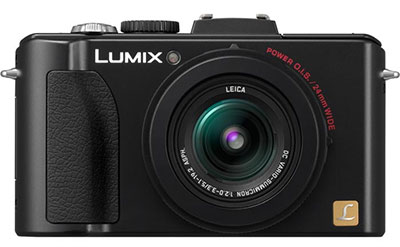
Considering the normal product cycle of pocket cameras, the Panasonic LX5, (which first shipped in August 2010), is becoming a little long in the tooth.
But sporting a high quality Leica lens, this Lumix LX5 shares a deluxe pedigree as a virtual clone of the twice as expensive Leica D-Lux 5.
Putting the talk about designer labels aside, the image quality of the LX5's RAW files is quite good.
As for compactness, the 24mm-90mm lens does not retract and the sturdily built body is one of the heaviest in the group, not exactly a pocket pal.
If you desire the Panasonic/Leica cachet and are the patient type, you could grab a deal as the price of the LX5 drops as it nears the end of its life cycle. Or simply wait for the new and improved LX6 (though no date has hit the rumor mill yet).
More about the Panasonic LX5 .
Samsung TL500
$399 with 3x Optical Zoom Lens, 10 MP - (More Specs)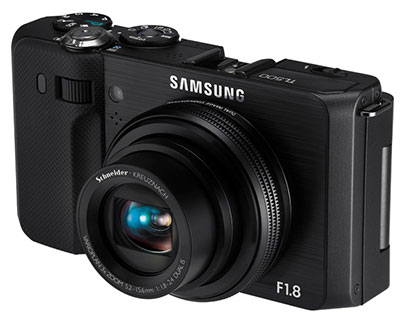
The Samsung TL500 (also called the EX-1 in some markets) is officially out of production, though at the time of this review, you can still purchase new stock online.
Being the biggest and heaviest model, the TL500 barely fits into this shootout category and only manages to slip into a cargo pants pocket.
But straight out of the camera, the RAW images are sharp and saturated. And if the picture quality doesn't make you forgive the extra few ounces of bulk, then the articulating screen will.
Not only does the rotating screen allow you to shoot at difficult angles, the bright and clear OLED screen is the best of the group, which is a welcome boon when shooting in glaring sunlight.
Samsung has not announced a replacement for the TL500.
Pocket Camera Compromises
Purchasing a camera always entails a series of compromises and tradeoffs.
Even though the price of a pocket camera isn't exactly pocket change, manufacturers try to control costs by using less expensive components or trimming certain features.
Most critically, all of these pocket cameras contain a relatively small image sensor, which is the heart of a digital camera. As a general rule, the bigger the sensor, the better.
The biggest image sensors of the five models in this shootout belong to the Panasonic LX5 and the Olympus XZ-1, (1/1.63") and the 1/1.7" sensors on the Samsung TL500 and Canon S100 are only slightly smaller. Still, as you can see from the diagram below, all those sensors are almost five times smaller than the one in a Micro 4/3 mirrorless camera.
Not only does picture quality suffer with a smaller sensor, but the cameras also don't perform as well in low light situations.
This is a tradeoff that many enthusiasts may not be willing to make for the pocket-ability of these cameras.
Sensor technology is constantly improving, but simply don't expect big sensor picture quality with these tiny sensor cameras and you won't be disappointed. (Admittedly, shooting outdoors in bright light often yields wonderfully colorful photos.)
In addition, none of these models provides a dedicated viewfinder. If you are stepping up from a smartphone or a point and shoot camera, that might not be a problem. If you depend on a viewfinder, expect to adjust your shooting style or shop elsewhere.
And the touchscreen phenomenon has yet not migrated to pocket cameras. On all of these cameras, you navigate through the menus with buttons and wheels.
Finally, the battery life on all these cameras is not that long, usually about 200 shots. This might seem like a minor issue until you are shooting your daughter's birthday party and the battery dies. If you buy one of these cameras, purchase at least one extra battery. You'll thank yourself later.
You can read more detailed individual reviews of these cameras on the following pages.
